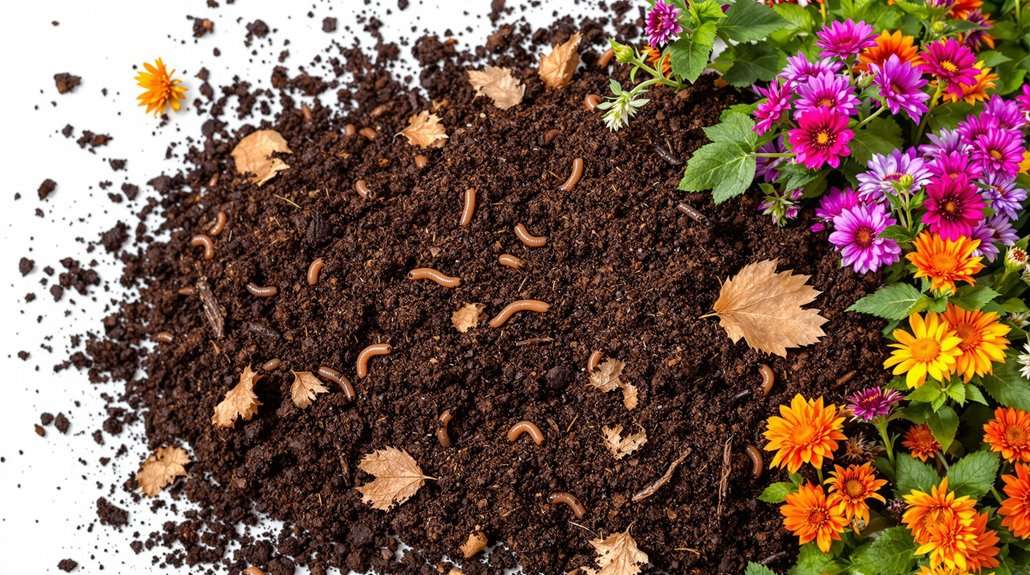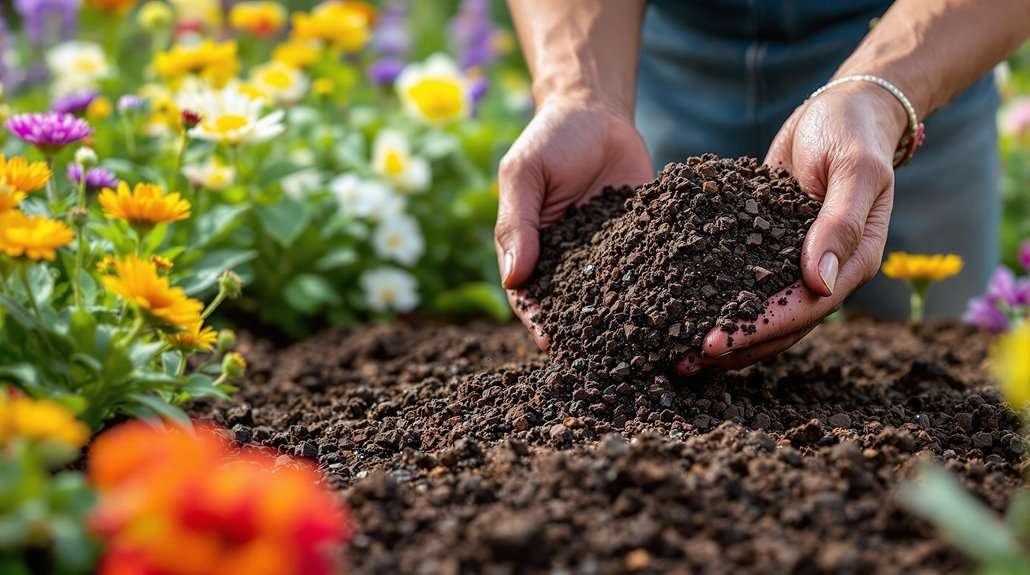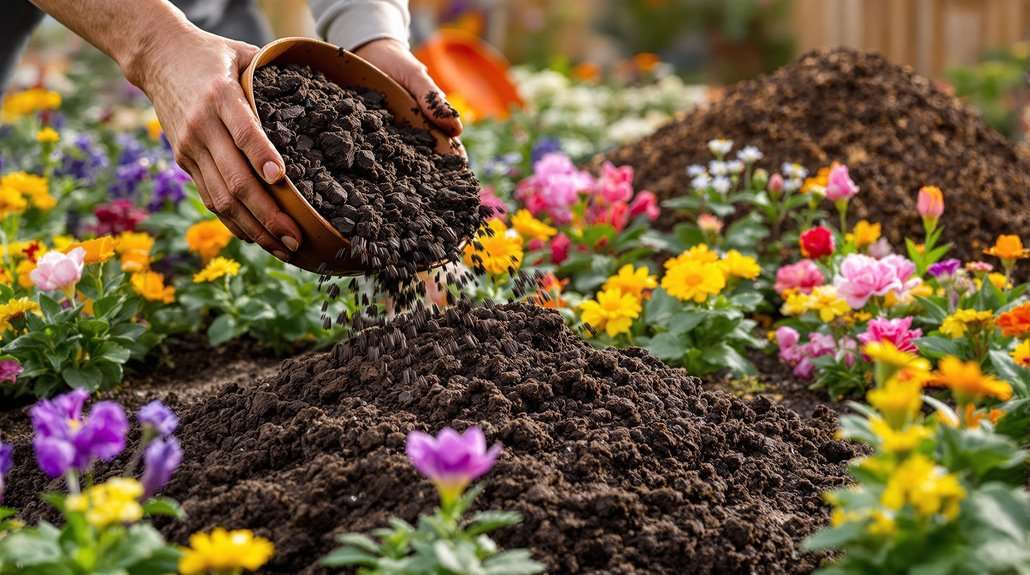Best Compost for Flower Beds
For the best flower bed results, you'll want to use a balanced compost mix consisting of equal parts compost and topsoil (50/50 ratio). Traditional green manure, farmyard manure, vermicompost, mushroom compost, and sea soil are all excellent options, with mushroom compost being particularly versatile for flower gardens. When applying, spread a 2-3 inch layer and work it into the top 12 inches of soil, being careful to keep the compost away from plant stems to prevent disease. Timing is essential – incorporate your chosen compost 2-4 weeks before planting in spring, or apply as a top dressing in fall. Understanding the specific benefits of each compost type will help you create the perfect growing environment for your flowers.
This post may contain affiliate links. If you make a purchase through these links, I may earn a commission at no additional cost to you. Additionally, portions of this post may be generated using artificial intelligence (AI) technology. While we strive for accuracy, please be aware that AI-generated content may not always be perfect and should be fact-checked when necessary.
The Spatula Scoops
- Mushroom compost is ideal for flower gardens, providing rich organic material and balanced nutrients for optimal flower growth.
- Use a 50/50 blend of high-quality compost and topsoil when preparing flower beds for best growing results.
- Apply a 2-3 inch layer of compost in spring or fall, incorporating it into the top 12 inches of soil.
- Vermicompost enhances seed germination and improves soil water retention, making it excellent for flower bed preparation.
- Choose professionally composted materials to ensure balanced nutrients and avoid potential plant damage from improperly decomposed matter.
Understanding Compost Types

When planning your flower bed, choosing the right compost can make the difference between thriving plants and mediocre growth. You'll find several types of compost available, each offering unique benefits for your garden's success. Traditional green manure crops have been used for centuries to naturally enrich garden soil.
Farmyard manure stands out as a nutrient-rich option that'll provide long-lasting benefits, though you'll need to apply it carefully to avoid damaging your plants. If you're looking for an all-around excellent choice, consider vermicompost, which enhances seed germination and improves your soil's ability to retain water. For versatility in different climates, mushroom compost proves ideal, especially in flower gardens, as it's packed with organic material that'll enrich your soil.
If you're growing acid-loving plants like rhododendrons or azaleas, you'll want to try sea soil, which is particularly beneficial for these species. You can also consider specialized options like John Innes No.3 for large, outdoor container plants, or worm castings to boost overall soil health. For the best results, you might want to combine different types, such as mixing organic bagged soil with composted manure to create a balanced growing medium.
Making Your Own Garden Compost
Creating your own garden compost offers a cost-effective way to transform household waste into rich, nutrient-dense soil for your flower beds. You'll need to gather both brown materials, like wood chips and leaves, and green materials, such as kitchen scraps and lawn clippings, in a ratio of about 2:1. The compost sandwich method creates highly fertile soil through layered decomposition.
To build your compost pile effectively, start with a brown layer at the base and maintain a size of at least 3 feet in diameter and height. You'll want to sprinkle some finished compost between layers to jumpstart microbial activity, and keep the pile consistently moist but not waterlogged.
- Set up a dedicated composting area using wire fencing or pallets
- Layer materials evenly, alternating between brown and green components
- Monitor the temperature, aiming for 100-120 degrees Fahrenheit
- Turn the pile when it reaches ideal temperature
- Add water as needed to maintain proper moisture levels
If you're short on space or prefer alternative methods, you can try trench composting or container composting. These techniques work well for smaller gardens and can be just as effective at producing quality compost for your flower beds.
Applying Compost to Flower Beds

Now that you've prepared your compost, proper application techniques will maximize its benefits in your flower beds. The key to success lies in timing and preparation – you'll want to work with moist soil in early spring or fall, clearing away any debris before you begin.
| Season | Soil Condition | Application Depth |
|---|---|---|
| Spring | Moist, not wet | 2-3 inches |
| Fall | Well-drained | 2-3 inches |
| Summer | Avoid if dry | Top dressing only |
You'll need to spread a 2-3 inch layer of compost evenly across your flower bed, then work it into the top 12 inches of soil. Don't walk on the bed while you're working – this'll prevent soil compaction. When applying around existing plants, keep the compost away from stems to prevent disease. Regular soil tests can help determine if additional amendments are needed.
After incorporation, lightly water the area and consider adding a thin layer of compost as mulch. You'll notice improved soil structure and moisture retention over time, and your flowers will thrive with this annual application. Remember, while compost is beneficial, you don't want to overdo it – stick to the recommended depths to maintain proper nutrient balance.
Choosing the Right Compost Mix
A flower bed's success largely depends on selecting the right compost mix for your specific needs. When choosing your compost, you'll want to take into account professionally composted materials that offer balanced nutrient content and proper decomposition. Look for screened and blended options that guarantee uniformity throughout your garden beds. Annual compost addition is typically sufficient to maintain optimal soil quality without needing complete replacement.
Several proven compost ratios can help you achieve the best results in your flower beds:
- Mix equal parts compost and topsoil (50/50) for a balanced growing medium
- Use Nicole Burke's 103 Blend, combining topsoil, compost, and coarse sand
- Layer your compost between soil materials for even nutrient distribution
- Incorporate 30% high-quality compost with other materials for proper structure
- Add 20% additional organic matter like aged leaves or worm castings
For the best results, select compost that contains diverse ingredients from various organic sources. You'll find options like Oakdell Compost or Nutri-Mulch offer excellent blends of manure, wood products, and organic materials. If you're dealing with clay or sandy soil, look for compost mixes specifically formulated to improve soil texture and structure. Remember to source your compost locally when possible, as it's often better suited to your region's soil conditions.
When to Add Compost

Timing plays an essential role when adding compost to your flower beds. You'll want to incorporate compost 2-4 weeks before planting to allow proper soil integration. In cold climates, apply a 1-inch layer, while warmer regions benefit from 2-3 inches due to increased biological activity. A blend of green and brown materials ensures optimal nutrient content in your compost mixture.
| Season | Application Method | Benefits |
|---|---|---|
| Spring | Mix into top soil | Enhanced nutrient availability |
| Summer | Side dress plants | Moisture retention |
| Fall | Top layer mulch | Winter protection |
During planting, you'll achieve the best results by using a 50/50 blend of compost and topsoil in your flower beds. Add a handful of compost to each planting hole, and consider using compost tea as a foliar spray for an extra nutrient boost. After planting, you're not done – continue adding compost as a mulch layer around your plants to suppress weeds and retain moisture.
For ongoing maintenance, monitor your soil's fertility and adjust your compost application accordingly. You'll want to test your soil pH seasonally and confirm you're using fully mature compost to avoid damaging your flowers. Remember to store unused compost in a sealed container to preserve its nutrient content.
Frequently Asked Questions
Can Compost Attract Unwanted Wildlife to My Flower Beds?
Just like a midnight buffet attracts hungry teenagers, your compost can attract wildlife if you're not careful! You'll want to avoid adding meat, dairy, oils, and seasoned foods to your compost. Instead, focus on plant materials and bury kitchen scraps under 8 inches of brown matter. You can protect your flower beds by using enclosed bins with secure lids, placing them away from bird feeders and natural food sources.
How Long Does Store-Bought Compost Remain Effective in Flower Beds?
Store-bought compost typically remains effective in your flower beds for 1-3 months, though this can vary based on several factors. You'll notice its effectiveness decline faster in warm, wet conditions due to increased microbial activity. The compost's composition matters too – those with higher organic matter content (50-60%) tend to last longer. For best results, you'll want to reapply the compost periodically and consider mixing it into the soil rather than just surface application.
Should I Remove Old Compost Before Adding New Layers?
Like peeling back layers of an onion, removing old compost isn't always necessary. You don't need to strip away existing compost unless you're noticing drainage issues or your soil's becoming overly dense. Instead, you can work new compost into the existing layers, maintaining a healthy soil ecosystem. If you spot problems like poor drainage or compaction, remove some old compost before adding fresh material to restore proper soil balance.
Will Compost Burn My Flowers if I Add Too Much?
Yes, excessive compost can burn your flowers by overloading them with nutrients, particularly nitrogen. You'll want to stick to the recommended ratio of 2-4 inches of compost mixed into the top 6-8 inches of soil. If you're worried, start with smaller amounts and monitor your plants for signs of burn, such as yellowing leaves or wilting. Remember, mature compost is less likely to cause burning than fresh material.
Does Adding Compost Affect the Color or Blooming of Flowers?
Just like a chef's secret ingredients enhance a dish's flavor, compost can dramatically affect your flowers' color and blooming. You'll notice more vibrant petals and prolific blooms when you add nutrient-rich compost, as it provides essential minerals that strengthen pigment production. It's especially effective with roses and dahlias, where you'll see deeper reds and brighter yellows. Remember, the soil's health directly impacts your flowers' visual appeal.





